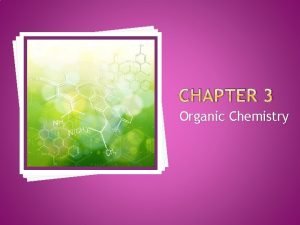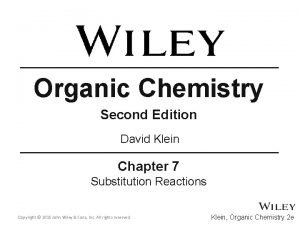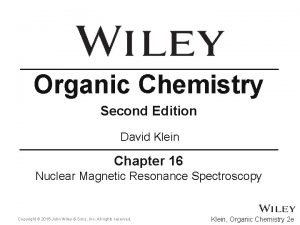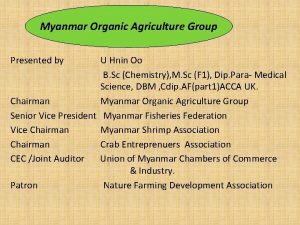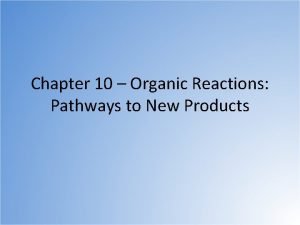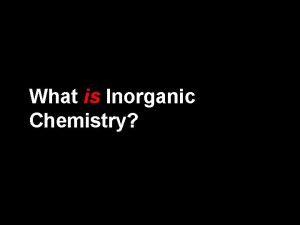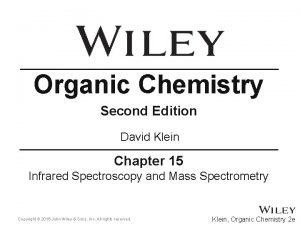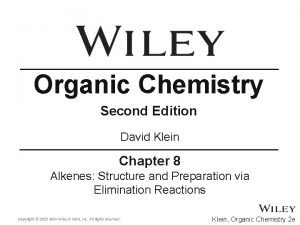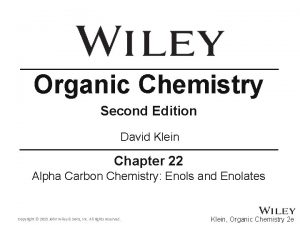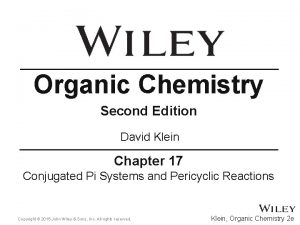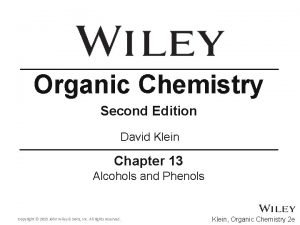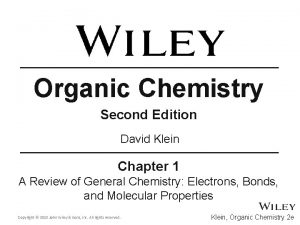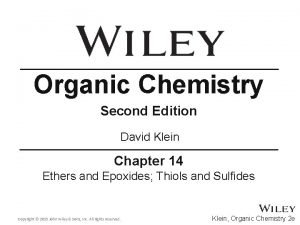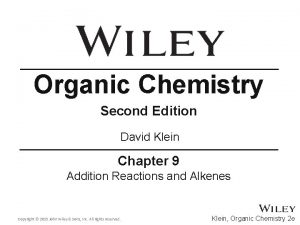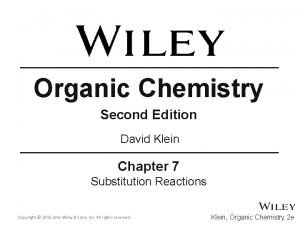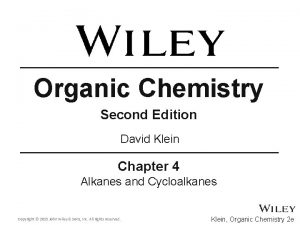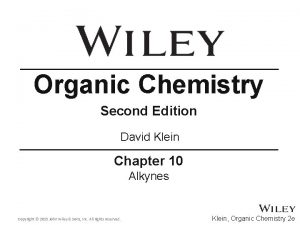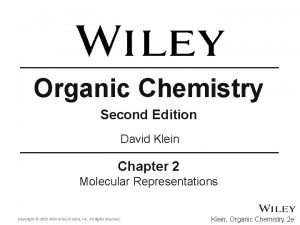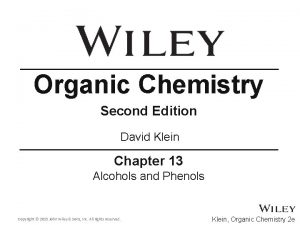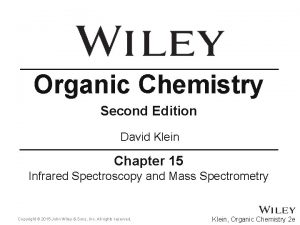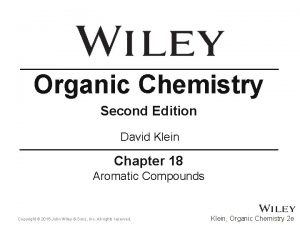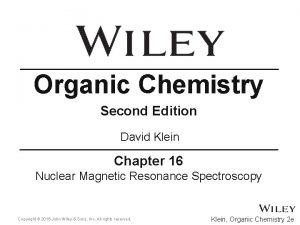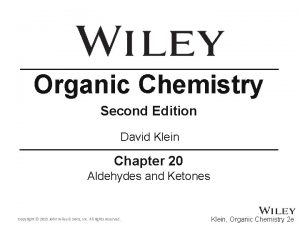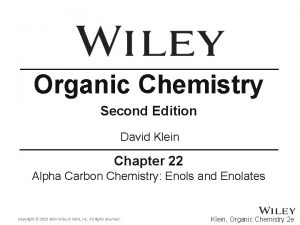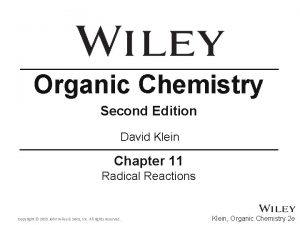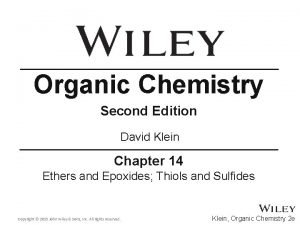Organic Chemistry Second Edition David Klein Chapter 12











































- Slides: 43

Organic Chemistry Second Edition David Klein Chapter 12 Synthesis Copyright © 2015 John Wiley & Sons, Inc. All rights reserved. Klein, Organic Chemistry 2 e

12. 1 One-Step Syntheses • When building a home, you must have the right tools, but you also need to know HOW to use the tools • When building a molecule (designing a synthesis), a lot of tools are available. Where are they? • To optimize your synthesis, you must understand HOW the tools work • What tools (reagents and conditions) are needed for the synthesis below? Copyright © 2015 John Wiley & Sons, Inc. All rights reserved. 12 -2 Klein, Organic Chemistry 2 e

12. 1 One-Step Syntheses • You may be able to solve one-step syntheses by matching the reaction pattern with an example in the text book – To add Br-Br across a C=C double bond, an alkene is generally treated with Br 2 / CCl 4 in the dark • How do you solve such syntheses without the textbook and without having to memorize each set of reagents? – Learning to use any tool requires PRACTICE – Its also helpful to know mechanisms. WHY? Copyright © 2015 John Wiley & Sons, Inc. All rights reserved. 12 -3 Klein, Organic Chemistry 2 e

12. 1 One-Step Syntheses • Solving one-step syntheses 1. Analyze the structures of the reactant and product 2. Assess HOW the functional groups have changed 3. Use the reactions and mechanisms you have learned to determine appropriate reagents and conditions 4. Check your answer by working out the mechanism • Solve the synthesis • Practice with conceptual checkpoints 12. 1 and 12. 2 Copyright © 2015 John Wiley & Sons, Inc. All rights reserved. 12 -4 Klein, Organic Chemistry 2 e

Copyright © 2015 John Wiley & Sons, Inc. All rights reserved. Klein, Organic Chemistry 2 e

Copyright © 2015 John Wiley & Sons, Inc. All rights reserved. Klein, Organic Chemistry 2 e

12. 2 Functional Group Transformations • Let’s review some synthetic tools we have learned so far • In chapter 9, we learned how to shift the position of a halide • The regiochemical considerations in this process are vital to making the correct product – see next slide Copyright © 2015 John Wiley & Sons, Inc. All rights reserved. 12 -7 Klein, Organic Chemistry 2 e

12. 2 Functional Group Transformations • Explain the regiochemistry for each reaction Copyright © 2015 John Wiley & Sons, Inc. All rights reserved. 12 -8 Klein, Organic Chemistry 2 e

12. 2 Functional Group Transformations • The techniques are slightly modified for an -OH group • Explain the regiochemistry for each reaction Copyright © 2015 John Wiley & Sons, Inc. All rights reserved. 12 -9 Klein, Organic Chemistry 2 e

12. 2 Functional Group Transformations • In chapter 9, we learned how to shift the position of a C=C double bond • Explain the regiochemistry for each reaction Copyright © 2015 John Wiley & Sons, Inc. All rights reserved. 12 -10 Klein, Organic Chemistry 2 e

12. 2 Functional Group Transformations • In chapter 11, we learned how to introduce a halide • With the introduction of a halide and its subsequent elimination, we can control the degree of saturation Copyright © 2015 John Wiley & Sons, Inc. All rights reserved. 12 -11 Klein, Organic Chemistry 2 e

12. 2 Functional Group Transformations • Practice with Skill. Builder 12. 1 • Give necessary reagents for the function group transformation below. Multiple steps are necessary Copyright © 2015 John Wiley & Sons, Inc. All rights reserved. 12 -12 Klein, Organic Chemistry 2 e

12. 3 Carbon Skeleton Transformations • There are many important molecules that have complex carbon skeletons • The ability to design syntheses that produce a desired carbon skeleton is highly prized • Some reactions will increase the number of carbons in the molecule • Some reactions will decrease the number of carbons in the molecule Copyright © 2015 John Wiley & Sons, Inc. All rights reserved. 12 -13 Klein, Organic Chemistry 2 e

12. 3 Carbon Skeleton Transformations • So far, we have learned only one transformation that increases the number of carbons in a molecule Copyright © 2015 John Wiley & Sons, Inc. All rights reserved. 12 -14 Klein, Organic Chemistry 2 e

12. 3 Carbon Skeleton Transformations • We have also learned a way to decrease the number of carbons in a molecule • In the future, we will discuss many more reactions that alter the carbon skeleton • Practice with Skill. Builder 12. 2 Copyright © 2015 John Wiley & Sons, Inc. All rights reserved. 12 -15 Klein, Organic Chemistry 2 e

12. 3 Carbon Skeleton Transformations • Give necessary reagents for the transformation below. Multiple steps are necessary Copyright © 2015 John Wiley & Sons, Inc. All rights reserved. 12 -16 Klein, Organic Chemistry 2 e

Copyright © 2015 John Wiley & Sons, Inc. All rights reserved. Klein, Organic Chemistry 2 e

Copyright © 2015 John Wiley & Sons, Inc. All rights reserved. Klein, Organic Chemistry 2 e

12. 4 Approach for Complex Syntheses • Some syntheses require a change in both the carbon skeleton and in the functional groups • Solving such syntheses 1. 2. 3. 4. Analyze the structures of the reactant and product Assess HOW the carbon skeleton has changed Assess HOW the functional groups have changed Review the proposed steps to make sure that the regioselectivity and stereoselectivity in each step lead to the desired product • Practice with Skill. Builder 12. 3 Copyright © 2015 John Wiley & Sons, Inc. All rights reserved. 12 -19 Klein, Organic Chemistry 2 e

12. 4 Approach for Complex Syntheses • For the synthesis below 1. 2. 3. 4. Analyze the structures of the reactant and product Asses HOW the carbon skeleton has changed Asses HOW the functional groups have changed Review the proposed steps to make sure that the regioselectivity and stereoselectivity in each step lead to the desired product Copyright © 2015 John Wiley & Sons, Inc. All rights reserved. 12 -20 Klein, Organic Chemistry 2 e

Copyright © 2015 John Wiley & Sons, Inc. All rights reserved. Klein, Organic Chemistry 2 e

Copyright © 2015 John Wiley & Sons, Inc. All rights reserved. Klein, Organic Chemistry 2 e

Copyright © 2015 John Wiley & Sons, Inc. All rights reserved. Klein, Organic Chemistry 2 e

Copyright © 2015 John Wiley & Sons, Inc. All rights reserved. Klein, Organic Chemistry 2 e

12. 5 Retrosynthetic Analysis • For more challenging, complex multi-step syntheses, it is often helpful to work backwards (retro) in our analysis, although the same basic analysis is performed • Perform a retrosynthetic analysis for the reaction below 1. Analyze the structure of the reactant and product. What functional groups are we dealing with? Copyright © 2015 John Wiley & Sons, Inc. All rights reserved. 12 -25 Klein, Organic Chemistry 2 e

12. 5 Retrosynthetic Analysis • Perform a retrosynthetic analysis for the reaction below 2. Assess HOW the carbon skeleton has changed. In this specific case, the carbon skeleton is not changing Copyright © 2015 John Wiley & Sons, Inc. All rights reserved. 12 -26 Klein, Organic Chemistry 2 e

12. 5 Retrosynthetic Analysis • Perform a retrosynthetic analysis for the reaction below • Work backwards: focus on the last step in the synthesis 3. Assess HOW the functional groups have changed. We want to make an alkyne, so what reactions do we know that can be used to make an alkyne? – see next slide Copyright © 2015 John Wiley & Sons, Inc. All rights reserved. 12 -27 Klein, Organic Chemistry 2 e

12. 5 Retrosynthetic Analysis – We only learned one method to synthesize an alkyne 1. Review the regioselectivity and stereoselectivity in each step Copyright © 2015 John Wiley & Sons, Inc. All rights reserved. 12 -28 Klein, Organic Chemistry 2 e

12. 5 Retrosynthetic Analysis • The last step in the synthesis must involve a geminal dihalide • WHY not a vicinal dihalide? How would a vicinal dihalide be made? Copyright © 2015 John Wiley & Sons, Inc. All rights reserved. 12 -29 Klein, Organic Chemistry 2 e

12. 5 Retrosynthetic Analysis • A retrosynthetic arrow is used by chemists to show the sequence of reactions in the reverse direction • Now, let’s continue the analysis by working another step backwards Copyright © 2015 John Wiley & Sons, Inc. All rights reserved. 12 -30 Klein, Organic Chemistry 2 e

12. 5 Retrosynthetic Analysis • Analyze the structure of the reactant and product. Do we know of a method to synthesize a geminal dihalide? – Yes, we can use an addition reaction – What reagents do we need? Copyright © 2015 John Wiley & Sons, Inc. All rights reserved. 12 -31 Klein, Organic Chemistry 2 e

12. 5 Retrosynthetic Analysis • In the full retrosynthetic analysis, so far we have the last two steps worked out Copyright © 2015 John Wiley & Sons, Inc. All rights reserved. 12 -32 Klein, Organic Chemistry 2 e

12. 5 Retrosynthetic Analysis • Recall that we used this method previously for converting alkenes to alkynes Copyright © 2015 John Wiley & Sons, Inc. All rights reserved. 12 -33 Klein, Organic Chemistry 2 e

12. 5 Retrosynthetic Analysis • One step remains in the analysis, so we can work in the forward direction • Why is the Ts group necessary? Copyright © 2015 John Wiley & Sons, Inc. All rights reserved. 12 -34 Klein, Organic Chemistry 2 e

12. 5 Retrosynthetic Analysis • Review the proposed steps to make sure that the regioselectivity and stereoselectivity in each step lead to the desired product • Practice with Skill. Builder 12. 4 Copyright © 2015 John Wiley & Sons, Inc. All rights reserved. 12 -35 Klein, Organic Chemistry 2 e

12. 5 Retrosynthetic Analysis • Perform a retrosynthetic analysis for the conversion below Copyright © 2015 John Wiley & Sons, Inc. All rights reserved. 12 -36 Klein, Organic Chemistry 2 e

Copyright © 2015 John Wiley & Sons, Inc. All rights reserved. Klein, Organic Chemistry 2 e

Copyright © 2015 John Wiley & Sons, Inc. All rights reserved. Klein, Organic Chemistry 2 e

12. 6 Practical Tips • • To build a molecule, you must be able to choose the right tools for the job It will be helpful if you create a list of tools and categorize them into two sets of reactions 1. Reactions that alter the carbon skeleton – see section 12. 3 2. Reactions that alter the functional groups – see section 12. 2 • As we learn more reactions, expand your list Copyright © 2015 John Wiley & Sons, Inc. All rights reserved. 12 -39 Klein, Organic Chemistry 2 e

12. 6 Create Your Own Problems • There will often be more than one way to solve a synthesis problem • In general, a chemist’s goal is to find the most facile synthesis generally having the fewest steps Copyright © 2015 John Wiley & Sons, Inc. All rights reserved. 12 -40 Klein, Organic Chemistry 2 e

Additional Practice Problems • Give necessary reagents for the transformation below. Copyright © 2015 John Wiley & Sons, Inc. All rights reserved. 12 -41 Klein, Organic Chemistry 2 e

Additional Practice Problems • Give necessary reagents for the transformation below. Copyright © 2015 John Wiley & Sons, Inc. All rights reserved. 12 -42 Klein, Organic Chemistry 2 e

Additional Practice Problems • Give necessary reagents for the transformation below. Copyright © 2015 John Wiley & Sons, Inc. All rights reserved. 12 -43 Klein, Organic Chemistry 2 e
 Klein
Klein Transition state energy diagram
Transition state energy diagram David klein organic chemistry
David klein organic chemistry Organic chemistry (3rd) edition chapter 1 problem 20s
Organic chemistry (3rd) edition chapter 1 problem 20s Organic chemistry third edition david klein
Organic chemistry third edition david klein Is alkane an organic compound
Is alkane an organic compound Organic chemistry
Organic chemistry Thermodynamic vs kinetic control
Thermodynamic vs kinetic control Halohydrin formation
Halohydrin formation Functional groups ib chemistry
Functional groups ib chemistry Organic vs inorganic chemistry
Organic vs inorganic chemistry Intro to organic chemistry
Intro to organic chemistry Chapter 22 review organic chemistry section 1 answers
Chapter 22 review organic chemistry section 1 answers Organic chemistry chapter 9
Organic chemistry chapter 9 Chapter 7 organic chemistry
Chapter 7 organic chemistry Entane
Entane Organic chemistry chapter 1 problem 59pp
Organic chemistry chapter 1 problem 59pp David klein
David klein David klein
David klein Father of organic chemistry
Father of organic chemistry Soap organic chemistry
Soap organic chemistry Ester organic chemistry
Ester organic chemistry Pentanoic acid structure
Pentanoic acid structure Ee organic chemistry
Ee organic chemistry Leveling effect organic chemistry
Leveling effect organic chemistry Ario practice problems
Ario practice problems Nomenclature of organic compounds
Nomenclature of organic compounds Organic chemistry lab report sample
Organic chemistry lab report sample Britannica.com
Britannica.com Organic chemistry grade 10
Organic chemistry grade 10 Cyclo organic chemistry
Cyclo organic chemistry Kiliani fischer synthesis
Kiliani fischer synthesis Organic chemistry crash course
Organic chemistry crash course How is cracking done
How is cracking done Eth meth prop but pent
Eth meth prop but pent Organic chemistry myanmar
Organic chemistry myanmar Hhcchh
Hhcchh Gc organic chemistry
Gc organic chemistry Hono organic chemistry
Hono organic chemistry Father of organic chemistry
Father of organic chemistry Topic 11 organic chemistry
Topic 11 organic chemistry Organic chemistry reaction pathways
Organic chemistry reaction pathways Alkene alcohol naming
Alkene alcohol naming What is organic chemistry like
What is organic chemistry like















